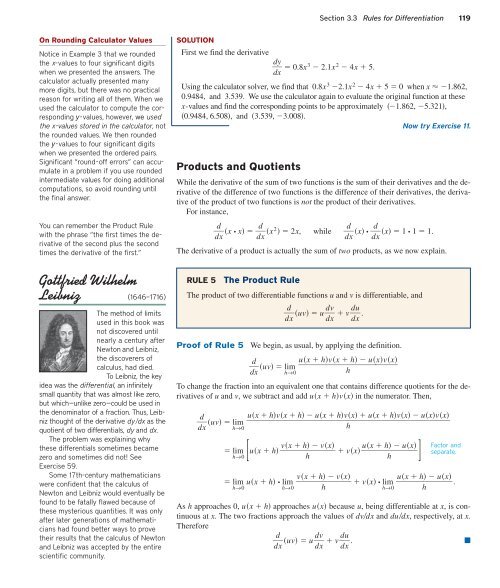5128_Ch03_pp098-184
Create successful ePaper yourself
Turn your PDF publications into a flip-book with our unique Google optimized e-Paper software.
Section 3.3 Rules for Differentiation 119<br />
On Rounding Calculator Values<br />
Notice in Example 3 that we rounded<br />
the x-values to four significant digits<br />
when we presented the answers. The<br />
calculator actually presented many<br />
more digits, but there was no practical<br />
reason for writing all of them. When we<br />
used the calculator to compute the corresponding<br />
y-values, however, we used<br />
the x-values stored in the calculator, not<br />
the rounded values. We then rounded<br />
the y-values to four significant digits<br />
when we presented the ordered pairs.<br />
Significant “round-off errors” can accumulate<br />
in a problem if you use rounded<br />
intermediate values for doing additional<br />
computations, so avoid rounding until<br />
the final answer.<br />
You can remember the Product Rule<br />
with the phrase “the first times the derivative<br />
of the second plus the second<br />
times the derivative of the first.”<br />
Gottfried Wilhelm<br />
Leibniz (1646–1716)<br />
The method of limits<br />
used in this book was<br />
not discovered until<br />
nearly a century after<br />
Newton and Leibniz,<br />
the discoverers of<br />
calculus, had died.<br />
To Leibniz, the key<br />
idea was the differential, an infinitely<br />
small quantity that was almost like zero,<br />
but which—unlike zero—could be used in<br />
the denominator of a fraction. Thus, Leibniz<br />
thought of the derivative dydx as the<br />
quotient of two differentials, dy and dx.<br />
The problem was explaining why<br />
these differentials sometimes became<br />
zero and sometimes did not! See<br />
Exercise 59.<br />
Some 17th-century mathematicians<br />
were confident that the calculus of<br />
Newton and Leibniz would eventually be<br />
found to be fatally flawed because of<br />
these mysterious quantities. It was only<br />
after later generations of mathematicians<br />
had found better ways to prove<br />
their results that the calculus of Newton<br />
and Leibniz was accepted by the entire<br />
scientific community.<br />
SOLUTION<br />
First we find the derivative<br />
d y<br />
0.8x<br />
dx<br />
3 2.1x 2 4x 5.<br />
Using the calculator solver, we find that 0.8x 3 2.1x 2 4x 5 0 when x 1.862,<br />
0.9484, and 3.539. We use the calculator again to evaluate the original function at these<br />
x-values and find the corresponding points to be approximately 1.862, 5.321,<br />
0.9484, 6.508, and 3.539, 3.008.<br />
Now try Exercise 11.<br />
Products and Quotients<br />
While the derivative of the sum of two functions is the sum of their derivatives and the derivative<br />
of the difference of two functions is the difference of their derivatives, the derivative<br />
of the product of two functions is not the product of their derivatives.<br />
For instance,<br />
d d<br />
x • x x d x d x<br />
2 d d<br />
2x, while x • x 1 • 1 1.<br />
d x d x<br />
The derivative of a product is actually the sum of two products, as we now explain.<br />
RULE 5<br />
The Product Rule<br />
The product of two differentiable functions u and v is differentiable, and<br />
d<br />
uv u d v<br />
v d u<br />
.<br />
d x dx<br />
dx<br />
Proof of Rule 5 We begin, as usual, by applying the definition.<br />
d<br />
ux hvx h uxvx<br />
uv lim<br />
d x h→0<br />
h<br />
To change the fraction into an equivalent one that contains difference quotients for the derivatives<br />
of u and v, we subtract and add ux hvx in the numerator. Then,<br />
d<br />
uv lim<br />
d x h→0<br />
lim<br />
h→0 [<br />
ux hvx h ux hvx ux hvx uxvx<br />
<br />
h<br />
ux hvx h vx<br />
h<br />
]<br />
vx ux h ux<br />
h<br />
Factor and<br />
separate.<br />
lim ux h • lim vx h vx<br />
vx • lim ux h ux<br />
.<br />
h→0 h→0 h<br />
h→0 h<br />
As h approaches 0, ux h approaches ux because u, being differentiable at x, is continuous<br />
at x. The two fractions approach the values of dvdx and dudx, respectively, at x.<br />
Therefore<br />
d<br />
uv u d v<br />
v d u<br />
. ■<br />
d x dx<br />
dx












